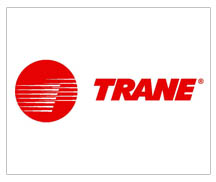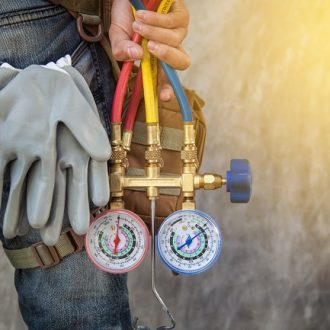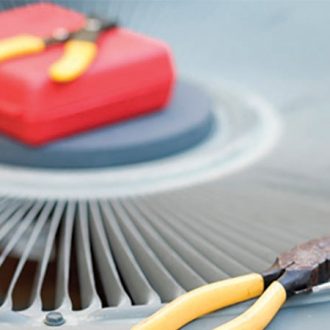To search for a specific term, use the index below to navigate to a specific letter. A B C D E F G H I J K L M N O P Q R S T U V W X Y Z
| Accumulator: |
Storage
tank which receives liquid refrigerant from evaporator and
prevents it from flowing into the suction line before vaporizing. |
| AFUE: |
Annual Fuel Utilization Efficiency.
Indicated as a percentage, your furnace AFUE tells you how
much energy is being converted to heat. |
| Air Handler: |
The evaporator section of an
air conditioning system that circulates and delivers the conditioned
air. The air handler is often referred to as the indoor
unit. It contains the evaporator coil, indoor fan motor
and generally a heat strip for supplemental heating. |
| Air Infiltration: |
Leakage of air into rooms through
cracks, windows, doors and other openings. |
| BTU: |
British
Thermal Unit. BTU is a measure of the heat given off
when fuel is combusted. One BTU is equal to the heat
given off by a wooden kitchen match. |
| Capacity: |
The ability
of a heating or cooling system to heat or cool a given amount
of space. For heating, this is usually expressed in
BTU. For cooling, it is usually given in tons. |
| Charge: |
The amount of refrigerant placed
in a refrigerating unit. |
| Compressor: |
Part of a split system heat
pump or air conditioner outdoor unit that controls the pressure
applied to the refrigerant, necessary for taking in heat to
warm your home or getting rid of heat to keep your home cool. |
| Condenser Coil: |
Part of a split system air conditioner
or heat pump. By converting refrigerant that is in a
gas form back to a liquid, the coil sends heat carried by
the refrigerant to the outside. |
| Condensing Unit: |
This section of an air conditioning
system pumps vaporized refrigerant from the air handler, compresses
it, liquefies it and returns it. It is often referred
to as the outdoor unit. |
| Damper: |
A type
of "valve" used in ductwork that opens or closes
to control airflow. Used in zoning to control the amount
of warm or cold air entering certain areas of your home. |
| Decibel (db): |
A decibel describes the relative
loudness of a sound. Some common sounds are fairly close
to a typical air conditioner or heat pump’s sound level:
human voice, 7.0 decibels; blender, 8.8. The average
sound rating range from 7.0 to 8.0 decibels. |
| Defrost Cycle: |
The process of removing ice
or frost buildup from the outdoor coil during the heating
season. |
| Dehumidification: |
The reduction of water vapor
in the air by cooling the air below the dew point; removal
of water vapor from the air by chemical means, refrigeration,
ect.. |
| Downflow: |
A type of furnace that takes
cool air from the top and blows warm air to the bottom – common
when your furnace must be located in a second floor closet
or utility area. |
| Duct: |
A pipe or closed conduit made
of sheet metal, fiberglass board, or other suitable material
used for conducting air to and from an air handling unit. |
| Ductwork: |
Pipes or channels that carry
air throughout your home. The delivery system through
which warm air from the furnace is brought to where it’s needed.
Ductwork is made of sheet metal, fiberglass, or flexible plastic,
and can be round or rectangular in shape. |
| Efficiency: |
A rating
on comfort equipment is similar to the miles per gallon rating
on your car. The higher the rating number, the more
efficient the system and the lower your fuel consumption will
be. You can save a lot of money with a high efficiency
unit. |
Electronic
Air Cleaner: |
An electronic device that filters
out large particles and contaminants in indoor air.
It then electronically pulls out tiny particles that have
been magnetized, such as viruses and bacteria, drawing them
to a collector plate. |
| Emergency Heat: |
The back up electric heat built
into a heat pump system. The same as an auxiliary heater,
except it is used exclusively as the heat source when the
heat pump needs repair. |
| Evaporator Coil: |
Part of a split system air conditioner
or heat pump located indoors. The evaporator coil cools
and dehumidifies the air by converting liquid refrigerant
into a gas, which absorbs the heat from the air. The
warmest refrigerant is then carried through a tube to the
outdoor unit (condenser coil). |
| Fan Coil: |
An indoor
component of a heat pump system, used in place of a furnace,
to provide additional heating on cold days when the heat pump
does not provide adequate heating. |
| Filter: |
Device used for removal of airborne
impurities or unwanted elements from liquids. Filtering or
"cleaning" the re-circulated air in a residential
or commercial building can be done by a variety of products
with differing levels of efficiency. Standard cardboard
frame filters are only about 15% effective in removing dust
and particles, and have no effect on pollen, micro-organisms,
smoke, and similar pollutants. Electrostatic filters
are much more effective. Electronic air cleaners and
HEPA (High Efficiency Particulate Air) filters produce the
best results. |
| Furnace: |
The part of an environmental
system which converts gas, oil, electricity or other fuel
into heat for distribution within a structure. |
| Heat Pump: |
A heat
pump is a reverse cycle air conditioner. It uses a compression
cycle system to supply heat or remove heat from a temperature
controlled space. When you run your air conditioner,
your outdoor unit will be blowing hot air (removing heat from
your home and sending it outside). When you run your
heat pump, you reverse the flow of refrigerant and remove
the heat from the atmoshpere outside and blow it inside.
When the temperature dips below 40 degrees outside, the heat
strip switches on to provide supplemental heat. Heat
strips are very expensive to operate. In southern climates,
such as Florida, heat pumps are very efficient. A 3
to 1 savings in heating compared to electric heat strips. |
| HFC: |
Hydrofluorocarbon. A class
of refrigerants. |
| Horizontal Flow: |
A type of furnace, installed
on its side that draws in air from one side, heats it and
sends the warm air out on the other side. Most often
used for installations in attics or crawl spaces. |
| HSPF: |
Heating Seasonal Performance
Factor. This is similar to SEER, but it measures the
efficiency of the heating portion of a heat pump. SEER,
industry minimums have been raised recently. The minimum
is now 6.80 HSPF. |
| Humidifier: |
A piece of equipment that adds
water vapor to heated air as it moves out of the furnace.
This adds necessary moisture to protect your furnishings and
reduce static electricity. |
| Humidity: |
The amount of moisture in the
air. Air conditioners remove moisture for added comfort. |
| HVAC: |
Heating, ventilating and air
conditioning refers to the indoor comfort industry. |
| Infiltration: |
Air flow inward
into a space through walls, leaks around doors, windows, or
through building materials in the structure. |
| Load Estimate: |
A series
of studies performed to determine the heating or cooling requirements
of your home. An energy load analysis uses information
such as the square footage of your home, window and door areas,
insulation quality and local climate to determine the heating
and cooling capacity needed by your furnace, heat pump or
air conditioner. |
| Matched System: |
A heating
and cooling system comprised of products that have been certified
to perform at promised comfort and efficiency levels when
used together, and when used according to design and engineering
specifications. |
| Operating Cost: |
The day
to day cost of running your home comfort equipment, based
on energy use. |
| Package Unit: |
A self
contained air conditioning unit that includes both the evaporator
and condenser sections within a single cabinet. It’s
advantages include simplicity of installation, which leads
to lower installation costs. However, a package unit
can create more noise and can be less energy efficient than
a split system. |
Reciprocating
Compressor: |
A type
of compressor used in air conditioners that compress refrigerant
by using a type of "piston" action. |
| Reclaiming: |
Returning used refrigerant to
the manufacturer for disposal or reuse. |
| Recycling: |
Removing, cleaning and reusing
refrigerant. |
| Refrigerant: |
Absorbs heat by a change of
state (evaporation) from a liquid to a gas, and releases heat
by a change of state (condenses) from a gas back to a liquid.
Freon® is the name commonly used for refrigerant, but this
is a brand name registered by Dupont. The correct name
for this gas is R-22. It is chlorofluorocarbon (CFC),
and its use is strictly regulated by the Federal Government
due to its effect on the ozone layer of the atmosphere. |
| Register: |
Combination grille and damper
assembly covering an air opening or end of an air duct. |
| SEER: |
Seasonal
Energy Efficiency Ratio. This is the approximate efficiency
of an air conditioning unit over a season in a given climate.
In the past, a unit with a SEER of 8.00 was considered standard
efficiency and a unit with a 10.00 SEER was considered high
efficiency. Since January 1st, 1992, the minimum SEER
required by the DOE is 10.00 and 15.00+ SEER is considered
high efficiency. |
| Scroll Compressor: |
A specially designed compressor
that works in a circular motion versus and up and down piston
action. |
| Setback Thermostat: |
A state of the art electronic
thermostat with a built in memory that can be programmed for
different temperature settings at different times of the day. |
|
Sound Rating Number (SRN):
|
Sound is measured in bels (a
bel equals 10 decibels). The SRN of a unit is based
on ARI test, performed at ARI standard rating conditions.
Average sound rating range is from 7.0 to 8.0 decibels.
The lower the SRN rating, the quieter the unit. |
| Split System: |
Refers to an air conditioner
or heat pump that has components in two locations. Usually
one part of the system is located inside (evaporator coil)
and the other is located outside you home (condenser coil). |
| Straight Cool: |
This is an air conditioner that
uses different forms of heating such as natural gas, LP gas,
electric resistance heat and oil. |
| Thermostat: |
Unit
that monitors and controls your HVAC system. |
| Time Delay: |
Usually refers to a device that
will not allow the condenser to restart for an average of
five minutes. |
| Ton: |
Heat pumps and air conditioners
are generally sized in tons. Typical sizes for a single
family residences are between two and five tons. Each
ton equals 12,000 BTU’s per hour. |
| Upflow: |
A type
of furnace that draws cool air from the bottom and blows the
warmed air out the top into the ductwork. This type
of furnace is usually installed in a basement or an out of
the way closet. |
| Ventilator: |
A ventilator
captures heating or cooling energy from stale indoor air and
transfers it to fresh incoming air. |
| Zoning: |
A way
to increase your home comfort and energy efficiency by controlling
when and where heating and cooling occurs in a home.
Programmable thermostats are used to control operating times
of the equipment. Dampers are used to direct airflow
to certain areas of the home. |




